Zhijie Liu
Intention-Aware Diffusion Model for Pedestrian Trajectory Prediction
Aug 10, 2025Abstract:Predicting pedestrian motion trajectories is critical for the path planning and motion control of autonomous vehicles. Recent diffusion-based models have shown promising results in capturing the inherent stochasticity of pedestrian behavior for trajectory prediction. However, the absence of explicit semantic modelling of pedestrian intent in many diffusion-based methods may result in misinterpreted behaviors and reduced prediction accuracy. To address the above challenges, we propose a diffusion-based pedestrian trajectory prediction framework that incorporates both short-term and long-term motion intentions. Short-term intent is modelled using a residual polar representation, which decouples direction and magnitude to capture fine-grained local motion patterns. Long-term intent is estimated through a learnable, token-based endpoint predictor that generates multiple candidate goals with associated probabilities, enabling multimodal and context-aware intention modelling. Furthermore, we enhance the diffusion process by incorporating adaptive guidance and a residual noise predictor that dynamically refines denoising accuracy. The proposed framework is evaluated on the widely used ETH, UCY, and SDD benchmarks, demonstrating competitive results against state-of-the-art methods.
Intention Enhanced Diffusion Model for Multimodal Pedestrian Trajectory Prediction
Aug 06, 2025Abstract:Predicting pedestrian motion trajectories is critical for path planning and motion control of autonomous vehicles. However, accurately forecasting crowd trajectories remains a challenging task due to the inherently multimodal and uncertain nature of human motion. Recent diffusion-based models have shown promising results in capturing the stochasticity of pedestrian behavior for trajectory prediction. However, few diffusion-based approaches explicitly incorporate the underlying motion intentions of pedestrians, which can limit the interpretability and precision of prediction models. In this work, we propose a diffusion-based multimodal trajectory prediction model that incorporates pedestrians' motion intentions into the prediction framework. The motion intentions are decomposed into lateral and longitudinal components, and a pedestrian intention recognition module is introduced to enable the model to effectively capture these intentions. Furthermore, we adopt an efficient guidance mechanism that facilitates the generation of interpretable trajectories. The proposed framework is evaluated on two widely used human trajectory prediction benchmarks, ETH and UCY, on which it is compared against state-of-the-art methods. The experimental results demonstrate that our method achieves competitive performance.
Unveiling the Impact of Multimodal Features on Chinese Spelling Correction: From Analysis to Design
Apr 10, 2025
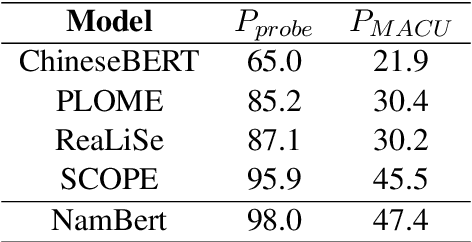
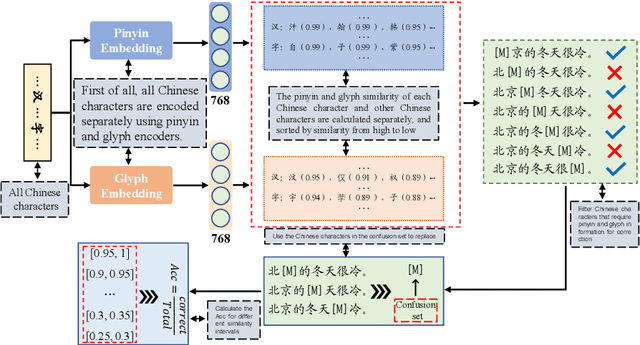
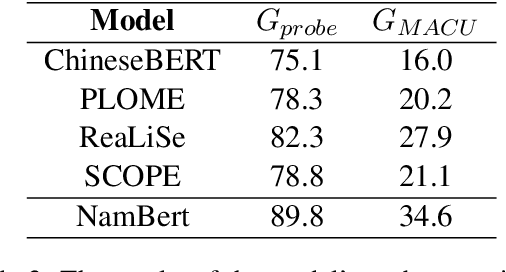
Abstract:The Chinese Spelling Correction (CSC) task focuses on detecting and correcting spelling errors in sentences. Current research primarily explores two approaches: traditional multimodal pre-trained models and large language models (LLMs). However, LLMs face limitations in CSC, particularly over-correction, making them suboptimal for this task. While existing studies have investigated the use of phonetic and graphemic information in multimodal CSC models, effectively leveraging these features to enhance correction performance remains a challenge. To address this, we propose the Multimodal Analysis for Character Usage (\textbf{MACU}) experiment, identifying potential improvements for multimodal correctison. Based on empirical findings, we introduce \textbf{NamBert}, a novel multimodal model for Chinese spelling correction. Experiments on benchmark datasets demonstrate NamBert's superiority over SOTA methods. We also conduct a comprehensive comparison between NamBert and LLMs, systematically evaluating their strengths and limitations in CSC. Our code and model are available at https://github.com/iioSnail/NamBert.
GenEM: Physics-Informed Generative Cryo-Electron Microscopy
Dec 04, 2023


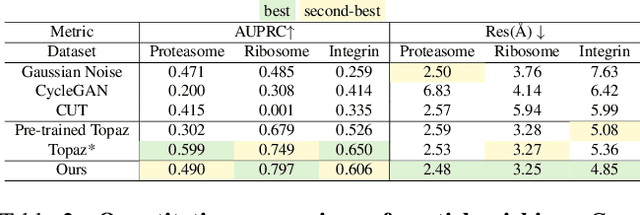
Abstract:In the past decade, deep conditional generative models have revolutionized the generation of realistic images, extending their application from entertainment to scientific domains. Single-particle cryo-electron microscopy (cryo-EM) is crucial in resolving near-atomic resolution 3D structures of proteins, such as the SARS-COV-2 spike protein. To achieve high-resolution reconstruction, AI models for particle picking and pose estimation have been adopted. However, their performance is still limited as they lack high-quality annotated datasets. To address this, we introduce physics-informed generative cryo-electron microscopy (GenEM), which for the first time integrates physical-based cryo-EM simulation with a generative unpaired noise translation to generate physically correct synthetic cryo-EM datasets with realistic noises. Initially, GenEM simulates the cryo-EM imaging process based on a virtual specimen. To generate realistic noises, we leverage an unpaired noise translation via contrastive learning with a novel mask-guided sampling scheme. Extensive experiments show that GenEM is capable of generating realistic cryo-EM images. The generated dataset can further enhance particle picking and pose estimation models, eventually improving the reconstruction resolution. We will release our code and annotated synthetic datasets.
Discovering Predictable Latent Factors for Time Series Forecasting
Mar 18, 2023Abstract:Modern time series forecasting methods, such as Transformer and its variants, have shown strong ability in sequential data modeling. To achieve high performance, they usually rely on redundant or unexplainable structures to model complex relations between variables and tune the parameters with large-scale data. Many real-world data mining tasks, however, lack sufficient variables for relation reasoning, and therefore these methods may not properly handle such forecasting problems. With insufficient data, time series appear to be affected by many exogenous variables, and thus, the modeling becomes unstable and unpredictable. To tackle this critical issue, in this paper, we develop a novel algorithmic framework for inferring the intrinsic latent factors implied by the observable time series. The inferred factors are used to form multiple independent and predictable signal components that enable not only sparse relation reasoning for long-term efficiency but also reconstructing the future temporal data for accurate prediction. To achieve this, we introduce three characteristics, i.e., predictability, sufficiency, and identifiability, and model these characteristics via the powerful deep latent dynamics models to infer the predictable signal components. Empirical results on multiple real datasets show the efficiency of our method for different kinds of time series forecasting. The statistical analysis validates the predictability of the learned latent factors.
Federated Forest
May 24, 2019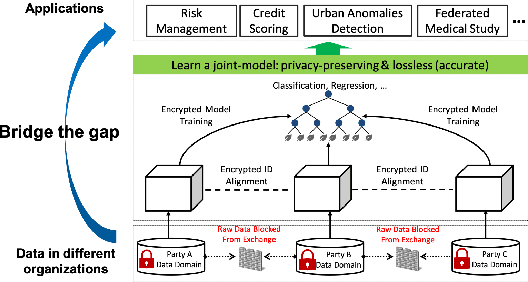
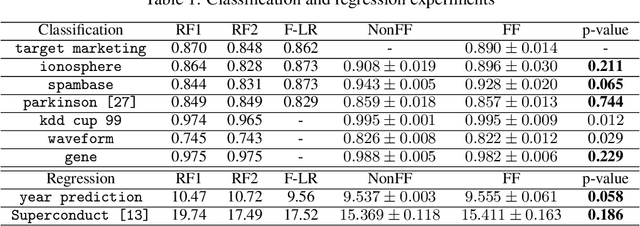
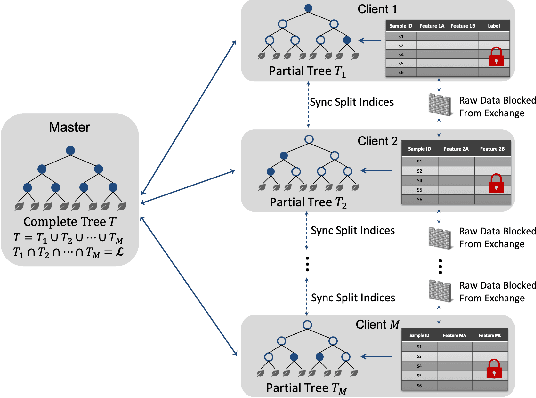
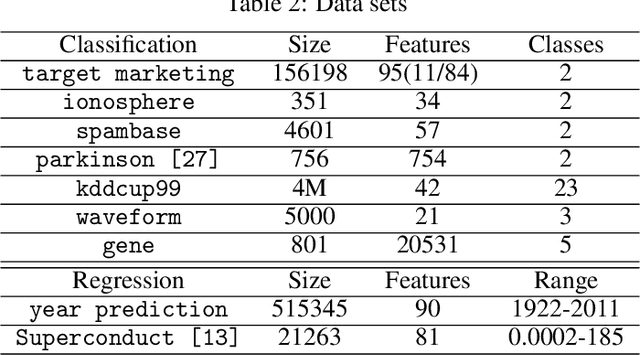
Abstract:Most real-world data are scattered across different companies or government organizations, and cannot be easily integrated under data privacy and related regulations such as the European Union's General Data Protection Regulation (GDPR) and China' Cyber Security Law. Such data islands situation and data privacy & security are two major challenges for applications of artificial intelligence. In this paper, we tackle these challenges and propose a privacy-preserving machine learning model, called Federated Forest, which is a lossless learning model of the traditional random forest method, i.e., achieving the same level of accuracy as the non-privacy-preserving approach. Based on it, we developed a secure cross-regional machine learning system that allows a learning process to be jointly trained over different regions' clients with the same user samples but different attribute sets, processing the data stored in each of them without exchanging their raw data. A novel prediction algorithm was also proposed which could largely reduce the communication overhead. Experiments on both real-world and UCI data sets demonstrate the performance of the Federated Forest is as accurate as the non-federated version. The efficiency and robustness of our proposed system had been verified. Overall, our model is practical, scalable and extensible for real-life tasks.
 Add to Chrome
Add to Chrome Add to Firefox
Add to Firefox Add to Edge
Add to Edge